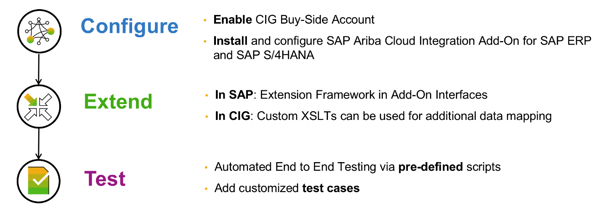SAP Ariba Cloud Integration Gateway
The intelligent enterprise is now more integrated than ever before. Customers are becoming more and more demanding in their integration needs, and rightfully so. In the digital age, customers want connected digital experiences across solutions and enterprises are looking to enhance the user experiences within their functions by connecting their businesses and customers to a seamless interface.
Let’s face it, in a time where everything seems to be connected, leaders in their departments are on the lookout for cloud solutions to be more agile; they want to increase collaboration, work from anywhere, and not worry about software and security updates – essentially working on what really matters to them and their clients.
As a by-product to the explosion of the number of cloud systems available today, these solutions, be it a top-notch Customer Relationship Management CRM solution or the newest peer-to-peer (P2P) software that promises to solve all your procurement needs, the integration effort is often overlooked by industry leaders.
Yes, you may have solved a critical issue that you were facing before investing in solution x, but what happens next is that this process needs to feed or be fed into another process, and this is where integration is critical.
Without a fully integrated suite of solutions, these systems will be working in silos. The same way executives and leaders of today are going all-out on challenging the silo mentality within teams and departments, integration efforts work the same way within on-premise and cloud solutions – they cannot be working in silos.
This article will introduce SAP Ariba’s latest integration solution – SAP Ariba Cloud Integration Gateway and how it promises to fulfill the big picture with regards to integration.
See the BIG picture
Every integration solution is different depending on the complexity of the enterprise; however, large enterprises most likely run hybrid solutions where cloud solutions are integrated with ERP systems deployed in either the cloud or on-premise. These companies may rely on SAP S/4HANA or SAP ERP as a single source of truth for their financial, inventory, supplier and material master data.
Before digging into what SAP Ariba Cloud Gateway is and what it offers, let us talk a little about how and where the SAP Ariba CIG fits into SAP integration efforts and give you some history on SAP’s history with regards to integration.
SAP understood early the need to build a single open platform-as-a-service platform for integrating cloud-based systems and 3rd party cloud solutions.
In 2012, SAP unveiled NetWeaver Cloud, and in 2013, the solution was reintroduced to SAP HANA Cloud Platform, which was then renamed to SAP Cloud Platform in February 2017 at the World Mobile Congress in Barcelona.
“Since the launch of our PaaS offering three years ago, it has evolved to become the digital enterprise platform of choice that enables customers, partners and developers to build differentiating solutions that intelligently connect people, things and businesses,” said Bernd Leukert, member of the Executive Board of SAP SE, Products & Innovation. “To represent its breadth of capabilities, it has been rebranded as SAP Cloud Platform. This platform creates digital differentiation by connecting a rapidly growing number of smart devices and machines with people and processes to achieve superior business outcomes.”
SAP Cloud Platform is an enterprise platform-as-a-service (enterprise PaaS) that provides comprehensive application development services which lets you build, extend and integrate business applications in the cloud.
SAP Cloud Platform Integration, SAP CPI
SAP Cloud Platform Integration, or in short SAP CPI, runs on top of the SAP Cloud Platform. SAP CPI’s main purpose is to support the end-to-end process integration across cloud-based and on-premise applications between SAP and Non-SAP solutions. In short, it allows you to securely run data and business processes between two or more applications, weather on the cloud or on- premise.
SAP Cloud Platform Integration Features:
- Out of the box integration: SAP CPI offers pre-packaged content to integrate SAP and non-SAP apps with more than 1000 pre-packaged integrations.
- Application-to-Application, A2A Integration: Integrates end-to-end process across SAP/non-SAP and cloud/on-premise solutions.
- Business-to-Business, B2B Integration: supports traditional EDI (Electronic Data Interchange) as well as real-time API based integrations. The solutions also support blockchain scenarios to foster trust in the network.
- Real-time API integration: supports omnichannel access and support API to hide the complexity around heterogeneous landscapes.
- Internet of Things, IoT Integration: Connects machines to core business processes to support real-time supply chain and digital manufacturing.
- Web-Based solution: The platform is entirely web-based.
- Multi-Level security: Data isolation with completely isolated tenants (memory, CPU, and database schema)
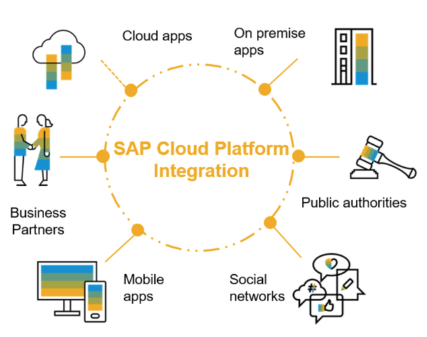 Source: SAP
Source: SAP
Do not confuse SAP Cloud Platform Integration with SAP PO/PI
SAP Process Orchestration (PO) and SAP Cloud Platform Integration (CPI) are, respectively, on-premise and cloud-based integration platforms that allow the synchronization of data between different systems to streamline business processes.
While all are considered middleware tools, think of SAP Process Orchestration and SAP Process Integration as the big brothers to SAP CPI. SAP PO was released in 2002 within the realm of the notoriously famous XI – Exchange Infrastructure offered by SAP.
Deciding between the two solutions can be cumbersome to solution managers but think about it this way: the SAP CPI platform is growing everyday with pre-packaged solutions and integrations. It is entirely cloud based, no need to worry about security and updates. It all depends on your current array of solutions today and your needs in the future. SAP PO is 16 years old, and SAP CPI is still evolving.
The question that you might ask is: But what will happen to SAP PO/PI in the future? SAP is still offering and supporting the two solutions and depending on your long-term plans with regards to investing in Cloud Applications, you can still rely on SAP PO/PI for your integration.
However, if your current array of solutions consists of cloud applications (think Concur, SAP Ariba, SuccessFactors, Fieldglass, and now Qualtrics) that will need to be further integrated with your on-premise SAP ERP or in the cloud with SAP S/4HANA, then SAP CPI needs to be brought to the table.
Again, it all depends on your design and your solution architecture and more importantly your long-term goals with regards to integration.
Take away
Cloud-cloud = SAP CPI
On prem-On prem = SAP PO
On prem – cloud = Either SAP CPI or SAP PO/PI or both
SAP Ariba Cloud Integration Gateway, SAP Ariba CGI
In the procurement world, buyers are looking to have an Amazon kind of experience when they are sourcing and buying direct and in-direct materials or services, and suppliers are on the lookout to collaborate with the buyers with quotations and PO flipping to Invoicing on a single platform. With more than 4.1M suppliers, SAP Ariba solutions and SAP Ariba Network are becoming more and more popular.
With the introduction of SAP Ariba Cloud Integration Gateway, or in short SAP CIG, SAP Ariba is investing heavily in its cloud integration gateway. Built on top of SAP Cloud Platform Integration: SAP CIG is an integration-as-a-service (IaaS) solution that redefines how buyers and suppliers to integrate in Ariba solutions with their backend SAP S/4HANA. In the future, SAP Ariba CIG will be the platform for all the future integrations and investments within SAP Ariba. Ariba Network Integration is only available for buying organizations, with supplier integration on the roadmap.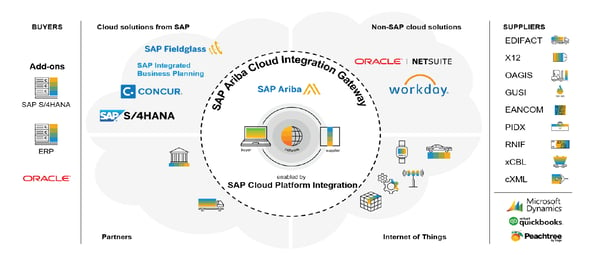 Source: SAP
Source: SAP
Companies may want to rely on SAP CIG as a single cloud platform to deploy and test their SAP Ariba integration solution. SAP Ariba Cloud Integration Gateway is entirely cloud-based and centralized, and it can be downloaded from the SAP ONE Support Launchpad.
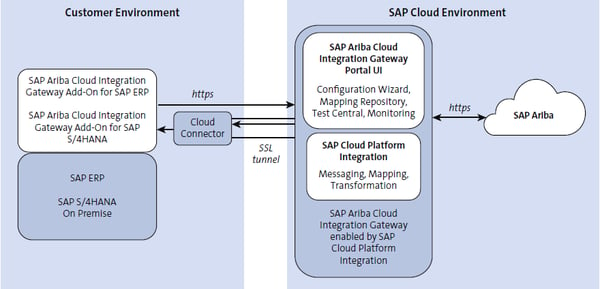
Source: SAP Ariba Business Processes Functionality and Implementation
In a simple example, a Purchased Order issued in SAP Ariba, follow-on processes, such as payment, invoice verification and inventory management updates might occur on the backend ERP or S/4HANA. To achieve true seamless data update between the two systems, multiple integration points will have to be set up.
SAP Ariba CIG relies on SAP CPI for the mapping, transformation and messaging. For incoming calls SAP Ariba CIG relies on HTTPS, and the Cloud Connector via the SSL connector for outgoing calls as shown in the figure above. You may also use SAP PI/PO, or SAP CPI as an integration middleware layer as shown in the figure above.
Once deployed and integrated with SAP Ariba, CIG provides easier browser access, quick and scalable upgrades by eliminating or largely reducing manual steps and increase the speed of procurement process all while enforcing compliance.
 SAP Ariba Cloud Integration Gateway works as bidirectional integration with 8000+ integrated fields
SAP Ariba Cloud Integration Gateway works as bidirectional integration with 8000+ integrated fields
Another benefit to SAP Ariba CIG is testing, SAP Ariba CIG provides self-service testing scripts through Test Central, which provides users the ability to test and deploy at their own pace in a centralized web-access environment. Test Central also comes with pre-defined standard test-cases to expedite the integration testing process.
SAP CIG Add-on Types
There are two available pre-packages depending on your SAP environment, SAP Ariba Cloud Integration Gateway add-on for both SAP ERP and SAP S/4HANA. Both add-ons are available from the SAP Service Marketplace from SAP ONE Support Launchpad.


SAP One Support Launchpad
While the initial release focuses on SAP ERP and SAP S/4HANA, for non-SAP ERP systems, SAP Ariba recommends Liaison Technologies and Dell Boomi's Open Adaptor.
There is no additional fee to download SAP Ariba CIG for customers who have subscribed to SAP Ariba Support contract with SAP.
Once installed on SAP S/4 or SAP ERP, you will be able to communicate with Ariba Network and SAP Ariba solutions, provided that you go through the installation and enabling the solution on SAP Ariba and on your SAP ERP or SAP S/4HANA.
SAP Ariba CIG Continued
Now that you have learned about integration, SAP Cloud Platform Integration, differentiating between SAP CPI and SAP PO/PI, let us take a closer look at SAP Ariba Cloud Integration Gateway.
Supported SAP Ariba Solutions
SAP Ariba CGI supports the following SAP Ariba Solutions with SAP ERP and S/4HANA:
| Ariba Network | SAP Ariba Invoice Management |
| SAP Ariba Buying | SAP Ariba Buying and Invoicing |
| SAP Ariba Buying, multi-ERP edition | SAP Ariba Catalog |
| SAP Ariba Sourcing | SAP Ariba Contract Invoicing |
| SAP Ariba Collaborative Sourcing | SAP Ariba Strategic Sourcing Suite |
| SAP Ariba Commerce Automation | SAP Ariba Contracts |
| SAP Ariba Discounting | SAP Ariba Supply Chain Collaboration |
| SAP Ariba Supplier Lifecycle and Performance |
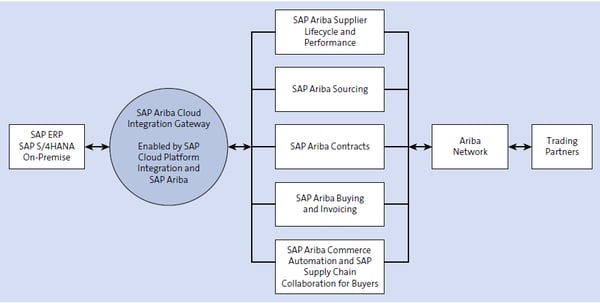 SAP Ariba Cloud Integration Gateway: Buy Side Integration
SAP Ariba Cloud Integration Gateway: Buy Side Integration
SAP Ariba recommends that you read the SAP Ariba Cloud Integration Over Guide for the prerequisites, limitation within the supported functionalities on SAP Ariba CIG and installation.
The below is a very high-level installation procedure of SAP Ariba CIG:
In a nutshell, SAP Ariba Cloud Integration Platform:
- Defines how the connection to the world's largest business network, SAP Ariba Network takes place.
- Defines the integration of SAP Ariba applications and 3rd party applications.
- Is designed as Integration as a Service (IaaS) solution. That is, the services are in the cloud.
- Is part of SAP Cloud Integration Platform, SAP CPI, which is based on SAP Cloud Platform.
- Supports the configuration of SAP Ariba applications and the associated processes with a self-service interface - even with external business partners.
- Supports over 200 integration scenarios, look below on already available integrations with ERP/S4 HANA.

Integration Between SAP S/4HANA/SAP ERP and SAP Ariba Procurement and Sourcing Applications
Conclusion
In numbers, SAP Ariba is huge. SAP Ariba is on track to process $3 Trillion USD in 2019 through the Ariba Network. If SAP Ariba is its own economy, it would be ranked in the Trillion Dollar Club, an un-official classification of the world`s major economies with gross domestic product (nominal GDP) of more than $1 USD Trillion per year. SAP Ariba is the largest business commerce network.
It is without doubt that SAP Ariba solutions are helping enterprises who are facing disruptions caused by geopolitics, market volatility, and language barriers while maintaining a positive social change.
SAP CIG integration add-on does not always replace middleware (SAP PO/PI), but the solution is growing with updates and functionalities. Implementation is now down weeks, a long shot from the time spent in integration efforts. Quality is also improved as everything sits centrally.
Give it a try! Contact our experts to learn more on how SAP Ariba can help your organization.
Download our whitepaper: "The Journey to the Intelligent Enterprise" and discover how to drivetotal customer experience, achieve a 15 – 20% productivity gain and transform the way we work and engage employees.
Sources:
- SAP Ariba Cloud Integration Gateway for buyers
- SAP CIG Config
- SAP Press - SAP Ariba Business Processes Functionality and Implementation
- https://blogs.sap.com/2019/02/20/ariba-cig-add-on-series-cig-add-on-installation/
- https://blogs.sap.com/2018/06/24/3-tips-for-successful-transition-to-sap-ariba-cloud-integration-gateway/
- https://blogs.sap.com/2018/10/08/sap-ariba-integration-using-cloud-integration-gateway/
- https://blogs.sap.com/2018/06/19/ariba-cig-add-on-series-cig-overview/
- https://blogs.sap.com/2018/06/24/sap-cloud-integration-vs-sap-process-orchestration/
- https://www.guru99.com/sap-pi-process-integration-tutorial.html
- https://www.linkedin.com/pulse/sap-ariba-live-celebrating-power-3-trillion-annual-tifenn-dano-kwan/





